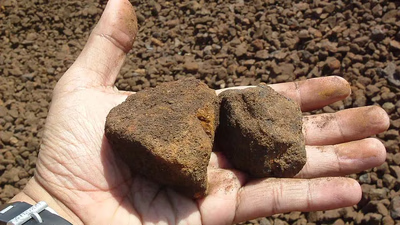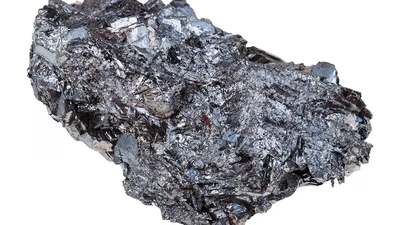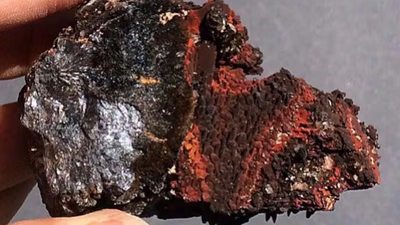
Hematite mineral showcasing its unique colors and properties.
Hematite is a type of precious stone that consists of the group of iron oxides. The name hematite comes from the Greek word \"haima\" It has been taken to mean blood, due to the red color of some hematite samples, which indicates blood. Hematite has a crystalline structure and is usually found in red, brown and gray colors. Chemically, hematite is iron oxide (Fe2O3). Mineralogically, this material is found in sedimentary rocks, iron ores and volcanic rocks. Hematite is used in industry as the main source of iron for the production of steel, and due to its strong magnetic properties, it plays an important role in the manufacture of electromagnetic components. a
Limonite and magnetite are two other types of iron mineral sources that are mined. Limonite is obtained from the hematite group and is usually found in sedimentary mines. Magnetite also belongs to the group of iron oxides, and the main element of iron in it is magnetite (Fe3O4). This mineral source is also found in sedimentary rocks and iron ores. Hematite usually consists of Z aqueous sediments. Over time, iron particles that contain iron from rocks, soil and other materials in the margins of rivers and lakes gradually accumulate with chemical and physical processes under pressure and temperature. This accumulation of particles is in the form of smooth iron deposits or in the form of thick layers that include hematite. These sediments turn into hematite stone over time.
Hematite can also be formed in the metabolic process of some living organisms. For example, in some aquatic environments, organisms such as bacteria and aquatic plants can reduce oxygen and extract iron from its dissolved forms. This process causes the formation of hematite deposits in the environment. Since hematite is one of the iron oxides, the processes of oxidation and chemical analysis of iron can play a role. Also, factors such as temperature, pressure, time and chemical environment also affect the formation of hematite
Some signs and symptoms in nature can be mentioned that may indicate the presence of hematite mineral. Of course, the exact diagnosis of the presence of hematite requires scientific investigation and careful analysis by mineralogists. Hematite is usually red, brown and sometimes gray in color. Therefore, the presence of similar colors in the stones and soils of the environment can be a sign of the presence of hematite. Hematite has a high iron content. Therefore, if soil, water, or other rocks suddenly turn brown or red near a hematite mine, this can be a sign of the presence of iron and hematite.
Hematite has magnetic properties. If a stone is associated with significant magnetic strength in nature, this can indicate the presence of hematite. Hematite is formed as a sedimentary rock, so the presence of red or brown sedimentary rocks in rivers and sedimentary areas can be a sign of hematite. Accurate diagnosis of the presence of hematite requires scientific and laboratory investigations, and for better assurance, it is recommended to refer to mineral and geological experts.
Hematite is also used in jewelry making and is considered as a precious stone due to its beautiful color and transparency. But it should be noted that not all hematite samples can be turned into jewelry and there is a great variety in their quality and value. The most important mineral source for iron extraction is hematite. Hematite is the main source of iron for steel production and is found in sedimentary rocks and iron ores. Some of the important hematite mines include mines in different countries such as Australia, Brazil, India, China, Russia and America.
-

Australia, Brazil, India, China, Russia, and the USA are key players in global hematite production. Australia leads with approximately 900 million tons annually, followed by Brazil at 480 million tons. India produces around 150 million tons, while China and Russia contribute 70 million and 30 million tons respectively. The USA also has significant resources with a production of about 30 million tons. Hematite mining methods vary based on location; open-pit mining is common for surface deposits, while underground mining is used for deeper reserves. Extraction techniques include crushing, washing, and separation processes to ensure high purity levels. Countries like China not only produce but also export substantial amounts of raw hematite to meet both domestic and international demands. The processed hematite is crucial for steelmaking industries worldwide.
-

The global hematite market is highly competitive, requiring exporters to differentiate their offerings and comply with varying international standards. Key challenges include navigating shipping logistics, cultural differences, and fluctuating exchange rates. Exporters must ensure compliance with regulations and obtain necessary certifications while managing payment risks through secure systems. Effective marketing strategies involve market research, quality assurance, and establishing strong relationships with foreign customers. Engaging local agents can facilitate market entry, while continuous evaluation of performance is essential for success. Countries like China, India, Japan, South Korea, and Germany present significant opportunities due to their high demand for iron ore in various industries. Adapting to changes in market dynamics and maintaining compliance with international laws are crucial for sustainable growth in the hematite export sector.
-

Hematite is an iron oxide mineral (Fe2O3) known for its red, brown, and gray colors. It is primarily found in sedimentary rocks and iron ores, playing a crucial role in steel production due to its high iron content. Hematite"s formation involves the accumulation of iron particles under pressure and temperature over time, often influenced by chemical processes in aquatic environments. Its magnetic properties make it significant for manufacturing electromagnetic components. The presence of hematite can be indicated by specific colorations in soil and rocks, as well as magnetic strength. While hematite is also used in jewelry making, not all samples are suitable for this purpose due to variations in quality. Major hematite mining countries include Australia, Brazil, India, China, Russia, and the USA. "
-

West Asia is rich in hematite reserves, with Iran, Iraq, Syria, Oman, and Saudi Arabia being key players in the region"s supply chain. Iran holds the largest deposits, particularly in Khorasan and Fars provinces. Iraq"s hematite is primarily found near Mosul and Kirkuk, while Syria has resources around Aleppo and Idlib. Oman’s Wadi Mandari region and Saudi Arabia’s Hijaz area also contribute significantly to the region"s hematite supply. The export dynamics of iron ore are influenced by local production capabilities and import needs from countries like Turkey, which sources from Brazil and Australia. The quality of hematite varies across regions; some areas produce high-quality hematite with a high iron concentration and low contaminants, while others yield lower quality ores. Economic factors such as exchange rates and market conditions play a crucial role in determining prices. Organizations like the Union of Steel Industries of the Persian Gulf facilitate cooperation among member states in mining activities.
The demand-supply balance for hematite directly impacts pricing; high demand coupled with low supply can lead to price increases. Countries like Iran, Saudi Arabia, Turkey, Oman, and Qatar are significant producers within this landscape. "




